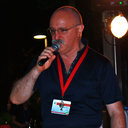Inhibition of granuloma formation induced by potassium permanganate in the mouse by a specific human recombinant receptor antagonist for interleukin-1 (hrIL-1ra).
Mots clés
Abstrait
Interleukin-1 (IL-1) is a polypeptide which mediates several systemic changes associated with infection, inflammation and injury, such as fever, neutrophilia, increased acute phase protein synthesis, and arachidonic acid metabolites. Recently, a natural inhibitor of IL-1 has been cloned, called IL-1 receptor antagonist (IL-1ra), which prevents Escherichia coli-induced shock in rabbits and blocks PGE2 induced by IL-1. In this report we study the effect of human recombinant (hr) IL-1ra on chronic inflammation induced by dorsal injections of 200 microliters of a 1:40 saturated crystal solution of potassium permanganate (KMnO4) in mice. After 7 days, all mice developed a subcutaneous granulomatous tissue indicative of a chronic inflammatory response, at the site of injection. KMnO4-treated mice, injected intraperitoneally twice with hrIL-1ra, 20 micrograms/dose (the first at the same time of induction of the granuloma and the second 24 hr later), show significant decreases in size and weight of the granuloma when compared to mice not treated with hrIL-1ra (controls); the inhibitory effect was approximately 32-46 and 25-51%, respectively. In addition, in all mice treated with hrIL-1ra, there was a strong inhibition of PGE2 and LTB4 on assay of freshly minced granuloma tissue. Moreover, when hrIL-1 beta (1.0 ng/ml) or LPS (100 ng/ml) were added overnight to the minced granuloma tissue cultures, these compounds enhanced the production of LTB4 and PGE2 from the untreated mice, whereas in IL-1ra-treated mice they failed. In the histological studies of the granuloma, animals treated with hrIL-1ra show a lesser degree of mononuclear cell (MC) accumulation. The inhibitory effect of hrIL-1ra on PGE2 production was also confirmed on peritoneal macrophages from untreated mice, stimulated overnight with hrIL-1 beta or LPS in vitro. The resulting inhibition was dose-dependent. In these studies we show, for the first time, the anti-inflammatory effect of hrIL-1ra on chronic inflammation as assessed by the inhibition of granuloma formation, PGE2, LTB4, and white cell accumulation in inflamed tissue.



